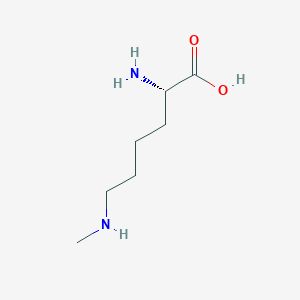| General Information of MET (ID: META00468) |
| Name |
N(6)-Methyllysine
|
| Synonyms |
Click to Show/Hide Synonyms of This Metabolite
(2S)-2-Amino-6-(methylamino)hexanoate; (2S)-2-Amino-6-(methylamino)hexanoic acid; (S)-2-Amino-6-methylaminohexanoate; (S)-2-Amino-6-methylaminohexanoic acid; Epsilon-N-Methyllysine; MeLys; N(6)-Methyl-L-lysine; N(6)-Methyllysine; N(epsilon)-Methyl-L-lysine; N(epsilon)-Monomethyl-lysine; N(zeta)-Methyllysine; N-Epsilon-Methyllysine; N-Methyl-L-lysine; N-Methyl-lysine; N6-Methyl-L-lysine; epsilon-Methyllysine; epsilon-N-Methyllysine hydrochloride, (L-lys)-isomer; epsilon-N-Methyllysine, (DL-lys)-isomer
|
| Source |
Endogenous;Food
|
| Structure Type |
Amino acids, peptides, and analogues (Click to Show/Hide the Complete Structure Type Hierarchy)
Organic acids and derivatives
Carboxylic acids and derivatives
Amino acids, peptides, and analogues
|
| PubChem CID |
|
| HMDB ID |
|
| Formula |
C7H16N2O2
|
| Structure |
<iframe style="width: 300px; height: 300px;" frameborder="0" src="https://embed.molview.org/v1/?mode=balls&cid=164795"></iframe>
|
 |
|
3D MOL
|
2D MOL
|
|
Click to Show/Hide the Molecular/Functional Data (External Links/Property/Function) of This Metabolite
|
| KEGG ID |
|
| DrugBank ID |
|
| ChEBI ID |
|
| FooDB ID |
|
| ChemSpider ID |
|
| Physicochemical Properties |
Molecular Weight |
160.21 |
Topological Polar Surface Area |
75.4 |
| XlogP |
-2.5 |
Complexity |
117 |
| Heavy Atom Count |
11 |
Rotatable Bond Count |
6 |
| Hydrogen Bond Donor Count |
3 |
Hydrogen Bond Acceptor Count |
4 |
| Function |
N(6)-Methyllysine is a naturally occurring amino acid found in human biofluids. N-monomethyl-lysine is generated by metabolic transmethylation of endogenous lysine. Lysine methylation displays the highest degree of complexity among known covalent histone modifications, with each site of methylation regulating the association of different effector molecules. The versatility of lysine methylation marks is perhaps best exemplified by modifications implicated in transcriptional regulation as well as being required for double-strand break repair in several organisms. Identification of the numerous biological functions encoded by histone lysine methylation is a major area of research interest, as these mechanisms are intimately associated with cellular senescence, genomic instability, and leukemogenesis. While multiple sites of lysine methylation have been linked with gene activation, each modification is distributed to unique positions across the active gene.
|
|
Regulatory Network
|
|
|
|
|
|
|
|
|
 click to show the details of this protein
click to show the details of this protein
 click to show the details of experiment for validating this pair
click to show the details of experiment for validating this pair

